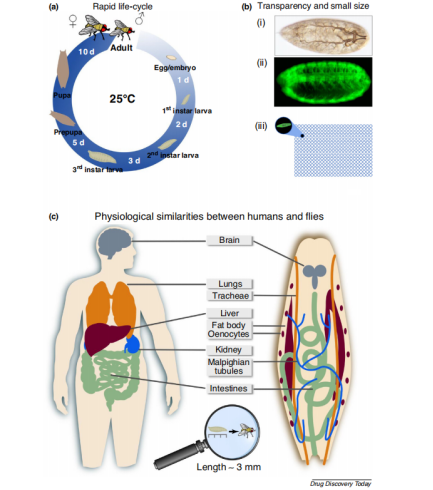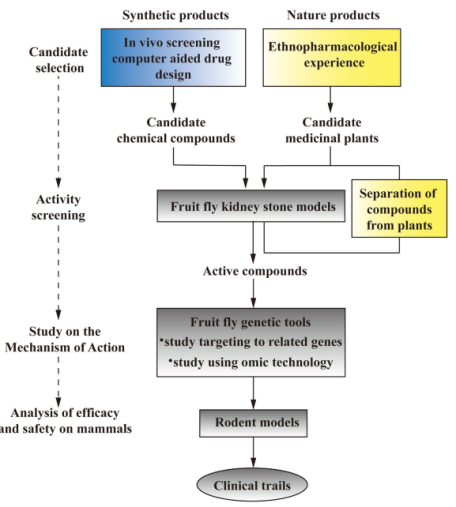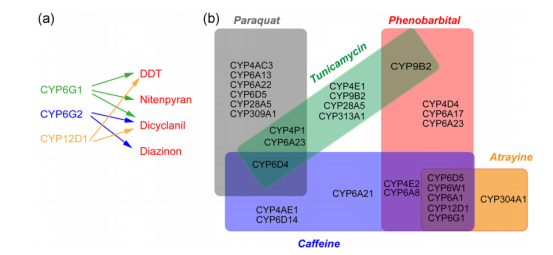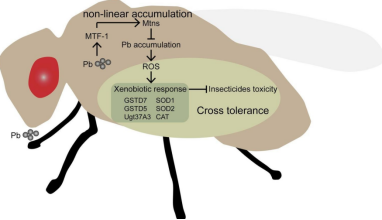Research fields 1: Utilizing Fruit Fly Human Disease Models for Drug Development.
研究方向1:利用果蝇人类疾病模型的新药开发
Fruit fly (Drosophila melanogaster) has emerged as a prominent model organism in biological research.. There is a high degree of gene conservation between the fruit fly and human, 75% of human disease-related genes have corresponding genes in the fruit fly. Additionally, many of the organs found in humans have analogous counterparts in fruit flies, each performing similar physiological functions. When compared to traditional rodent models, fruit flies offer several distinct advantages such as cost-effective breeding, shorter experimental timelines, a well-annotated genome, and an array of genetic modification techniques (Fig. 1). These attributes collectively position the fruit fly as a highly promising animal model for both fundamental genetic research and large-scale in vivo drug screening.

Figure 1: Biology of the fruit fly Drosophila melanogaster relevant for its use in disease research and drug developments.
Our laboratory has successfully established various human disease models using fruit flies, like type 2 diabetes model, hyperuricemia model, kidney stone model, and parkinsons’disease model, among others. Leveraging these models, our research efforts are dedicated to delving into the underlying pathogenic mechanisms and advancing the development of innovative treatments.
1. The Role of Gut Microbiota in the Development of Insulin Resistance (肠道菌群在胰岛素抵抗形成中的作用):In the case of the type 2 diabetes model, our focus is on investigating the role of the gastrointestinal microflora in the development of insulin resistance. We aim to elucidate the precise interaction between the gastrointestinal microflora and various cellular signaling pathways, including but not limited to JNK, and JAS/STAT pathways (Journal of Drug Targeting, 31:1-16)).
2. Evaluation of Novel Treatment Strategies (新型治疗策略的评估):Within the hyeruricemia model, we have assessed the therapeutic potential of engineered gut bacteria that produce purinolytic enzymes (Cell Chemical Biology, 8:1-9).
3. Exploration of Therapeutic Activity and Mechanisms of Action of Natural Compounds (天然产物的治疗活性和治疗机理挖掘):We are also keeping on exploring the therapeutic properties of Traditional Chinese Medicines (TCM) and nature produces in the context of different diseases using our fruit fly human disease models. We have identified active compounds form herbal drugs of TCM, and illuminated their therapeutic mechanisms at molecular level using fruit fly genetic tools (Journal of Ehnopharmacology, 316:116760, Pharmacological Research-Modern Chinese Medicine, 6:100220). The diagram below (Fig 2) provides an overview of our well-established workflow empolying fruit fly models for innovative drugs screening (kidney stone shown as example).

Figure 2:Schematic representation of our workflow for drug screening using fruit fly models (Kidney stone model shown as an example).
Research fields 2: Insect Detoxification Metabolism and Its Ecological Impacts
研究方向2:昆虫解毒代谢与其生态影响
Insects have developed highly efficient detoxification systems to safeguard themselves against a broad spectrum of environmental and anthropogenic xenobiotics, encompassing organic and inorganic pollutants, nanoparticles, and pesticides. The genetic and physiological adaptations that occur in insects following exposure to diverse xenobiotics, along with the resulting development of tolerance to pollution and insecticides, exert significant impacts on ecosystems and agriculture.
unraveling the intricate detoxification strategies employed by insects, with a primary emphasis on utilizing the fruit fly as a model organism. We investigate these mechanisms at the molecular level, aiming to uncover the regulatory pathways that govern detoxification processes. Our research extends to explore the consequent physiological alterations and their far-reaching ecological effects on a larger scale. This knowledge is critical for understanding how insects respond to changing environmental conditions, xenobiotic exposure, and the potential consequences for ecosystems and agriculture. Our research contributes to a comprehensive understanding of insect ecology and serves as a foundation for informed conservation and pest management strategies.
Our topics include:
1. Understanding the Insect Detoxification System Specificity (昆虫解毒系统特异性研究): We aim to unravel how the insect detoxification system, despite its relatively unspecific recognition of a wide range of potential toxic substances, manages to provide specific responses to different inducers (Fig 3). To address this question, we will (1) analyze the differential cross-talk between known canonical xenobiotic response signaling pathways, including CncC/Keap1, HR96, AHR/ARNT, GPCR, and MAPK/CREB, and (2) explore unidentified regulators and pathways. This research will illuminate the molecular mechanisms governing insect detoxification and its adaptability (Archives of Insect Biochemistry and Physiology. 109, DOI: 10.1002/arch.21869).

Fig3: Specific responses of insect detocificaiton system to different inducers
2. Impact of Pesticide Modes of Action (MoAs) and Modes of Entry (MoEs) on Detoxifiction Resposnes (农药作用机理和给药方式对昆虫解毒反应的影响): We investigate the extent to which different pesticide modes of action (MoAs) and modes of entry (MoEs) influence detoxification responses and pesticide tolerance in insects. Additionally, we seek to uncover the regulatory mechanisms underpinning these diverse effects. This research is critical for comprehending how pesticides affect insect populations and may inform more effective pest management strategies (Archives of Insect Biochemistry and Physiology. 111, DOI: 10.1002/arch.21958).
3. Genetic Response to Metal Exposure, Metabolism of Toxic Metals and related ecological impacts (昆虫对金属暴露的基因应答和毒性金属代谢,及其生态影响): We delve into the genetic responses of insects, notably D. melanogaster, to metal exposure, such as Pb ions. Our research investigates the metabolic processes of toxic metals and the intricate interactions between heavy metal stress and other xenobiotic response pathways. Our findings indicate that expressions of Mtns, especially MtnB, can be directly induced by Pb exposure via the MTF-1 pathway. These genes contribute to reducing Pb accumulation in flies when exposed to high levels of Pb. Furthermore, exposure to Pb activates the expression of specific anti-oxidation and detoxification enzymes, enhancing the flies' antioxidative capacity and enabling them to resist xenobiotics, including insecticides. Consequently, we propose an intricate interaction between heavy metal homeostasis and xenobiotic response pathways in D. melanogaster (Fig. 4) (The Science of The Total Environment, 900:165680).

Figure 4: An intricate interaction between heavy metal homeostasis and xenobiotic response pathways in D. melanogaster
Our research extends beyond fruit flies and includes other insects like Propsilocerus akamusi (International Journal of Biological Macromolecules, 223, DOI: 10.1016 /j.ijbiomac. 2022.10.279 ).




